Are you struggling with persistent jaw pain, teeth grinding, or jaw tension? You’re not alone. Millions of people silently suffer from bruxism and TMJ disorders—often without even knowing the root cause. Whether you’re clenching your teeth at night or experiencing jaw discomfort during the day, understanding the connection between TMJ and bruxism is crucial for finding lasting relief. In this guide, we’ll explore how innovative solutions, such as bruxism biofeedback and TMJ biofeedback, offer a natural, drug-free approach to reducing clenching, easing muscle tension, and alleviating pain at its source. You’ll also discover how a bruxism biofeedback device can help retrain your jaw muscles and put an end to chronic bruxism and jaw pain—all from the comfort of home.
Table of Contents
Toggle- How to Fix Bruxism and TMJ Naturally Without Medication
- What Are Bruxism and TMJ Disorders—and Why Should You Care?
- Top Warning Signs of TMJ and Bruxism You Shouldn’t Ignore
- Why Do I Clench My Jaw? The Triggers Behind the Pain
- The Vicious Cycle of Bruxism and TMJ: Why It Keeps Getting Worse
- Why Traditional Treatments Fail to Fix TMJ and Bruxism
- The Natural Alternative: How a Bruxism Biofeedback Device Breaks the Cycle
- The Mind-Body Solution for TMJ and Bruxism Pain Relief
- Hidden Symptoms and Root Causes of Bruxism and TMJ
- Target the Root Cause with TMJ Biofeedback and Natural Retraining
- How Biofeedback for Bruxism and TMJ Works
- What Is Biofeedback? The Science Behind the Solution
- Why Bruxism Biofeedback Devices Work When Other Treatments Don’t
- How Biofeedback Trains Your Brain to Stop Clenching
- Who Can Benefit from Biofeedback for Bruxism and Jaw Pain?
- How Fast Does Biofeedback Work for TMJ and Bruxism Relief?
- Why Biofeedback Is the Missing Piece in TMJ and Bruxism Treatment
- Step-by-Step Guide – How to Use a Bruxism Biofeedback Device for TMJ and Jaw Pain Relief
- Combine with Supportive Habits for Maximum Results
- The Natural Boost – Exercises, Diet, and Stress Relief to Supercharge Your Bruxism and TMJ Recovery
- Bruxism and TMJ FAQs About Biofeedback, Relief, and Recovery
- Conclusion: Take Back Control – End Bruxism and TMJ Naturally and Permanently
- References
How to Fix Bruxism and TMJ Naturally Without Medication
Jaw pain, morning headaches, tight facial muscles, and worn-down teeth—these are just a few of the warning signs your body is sending you. If you’ve been waking up with discomfort or feel tension creeping in during the day, you could be caught in the harmful loop of bruxism and TMJ pain.
Let’s break this cycle by uncovering the real cause and the most effective natural solution.
What Are Bruxism and TMJ Disorders—and Why Should You Care?
Bruxism refers to the habitual, often unconscious, grinding of teeth and clenching of the jaw, especially during sleep. Meanwhile, TMJ disorders (short for temporomandibular joint dysfunction) involve pain, inflammation, or misalignment in the joint that connects your jawbone to your skull.
These two conditions are deeply interconnected.
When you grind your teeth:
- You place intense pressure on your jaw muscles.
- You overload the TMJ joint.
- You trigger a cascade of inflammation, tension, and chronic pain.
In short: TMJ and bruxism don’t just coexist—they worsen each other.
Top Warning Signs of TMJ and Bruxism You Shouldn’t Ignore
People often dismiss or misdiagnose these symptoms. But early recognition is the key to relief. Do any of these sound familiar?
- Morning jaw soreness or tension
- Headaches that begin at the temples
- Clicking, popping, or locking of the jaw joint
- Teeth grinding sounds noticed by a partner
- Difficulty chewing, yawning, or talking
- Flattened, cracked, or sensitive teeth
- Ringing in the ears (tinnitus) without infection
If you check even two of these boxes, you may be dealing with bruxism and jaw pain related to TMJ dysfunction.
Why Do I Clench My Jaw? The Triggers Behind the Pain
Understanding what’s causing your symptoms is the first step to fixing them. Surprisingly, most people don’t realize that stress, poor posture, and sleep disorders are fueling the problem.
- Emotional stress activates your nervous system and tightens jaw muscles.
- Cortisol spikes at night can lead to nighttime teeth grinding.
- Even thinking about stress can cause involuntary clenching.
2. Sleep Disturbances
- Sleep apnea and insomnia lead to micro-arousals that trigger jaw tightening.
- The body may grind teeth to reopen airways during sleep.
3. Misaligned Bite or Missing Teeth
- Uneven pressure forces muscles to overcompensate.
- This leads to strain on the temporomandibular joint.
4. Excessive Stimulants
- Caffeine, alcohol, and energy drinks increase grinding episodes, especially during REM sleep.
5. Forward Head Posture
- “Tech neck” causes your head to lean forward unnaturally.
- This stretches and tenses the jaw and neck muscles.
The Vicious Cycle of Bruxism and TMJ: Why It Keeps Getting Worse
The relationship between bruxism and TMJ pain creates a self-reinforcing loop:
- Teeth grinding puts pressure on the TMJ.
- The TMJ becomes inflamed, triggering nerve irritation.
- Pain signals increase muscle tension.
- You clench more often, unconsciously—especially at night.
- Sleep quality deteriorates, and healing becomes more challenging.
It’s a cycle of stress, strain, and pain.
Bruxism and TMJ disorders don’t just coexist—they fuel each other in a self-destructive loop.
Here’s how this cycle works, step by step:
Bruxism Damages the Jaw Joint
When you grind or clench, your jaw muscles generate extreme force—enough to crack a walnut. Over time, this strain can affect the temporomandibular joint (TMJ), the delicate hinge that connects the skull and jaw.
Mechanism:
- The TMJ’s cartilage disc acts as a shock absorber. Grinding can displace or tear this disc, causing clicking, popping, or locking.
- Chronic pressure erodes the joint’s bone surfaces, similar to arthritis.
Result:
- Pain spreads to your jaw, temples, or ears—even when you’re not grinding.
TMJ Pain Triggers More Grinding
Pain doesn’t just hurt—it rewires your nervous system. Inflamed TMJ tissues irritate the trigeminal nerve, the largest nerve in your head. This nerve controls jaw movement and amplifies muscle tension as a misguided protective reflex.
How it backfires:
- Your brain subconsciously clenches to “stabilize” the joint, worsening the damage.
- Pain disrupts sleep, increasing nighttime grinding episodes.
Evidence:
- 70% of TMJ patients report worse symptoms after stressful days.
Stress Traps You in the Cycle
Stress isn’t just emotional—it’s physical. When anxious, your body releases cortisol, a hormone that primes muscles for action. Your jaw muscles (masseters) are especially vulnerable because they’re wired to react instantly to threats.
The domino effect:
- Stress → jaw clenching → TMJ pain → more stress → repeat.
- Even thinking about stress can tense your jaw (try it now—did you clench?).
Sleep Disorders Add Fuel to the Fire
Grinding isn’t always about stress. For many, it’s the body’s desperate attempt to keep airways open during sleep apnea or shallow breathing.
The cruel twist:
- Grinding just the jaw forward to open the airway, but strains the TMJ further.
- Poor sleep reduces pain tolerance, making TMJ discomfort feel worse.
In plain terms:
Bruxism and TMJ pain are like two people screaming at each other in a echo chamber. Biofeedback turns down the volume.
Why Traditional Treatments Fail to Fix TMJ and Bruxism
While many common treatments for bruxism and TMJ disorders provide temporary relief, they often fail to address the underlying problem. Here’s why:
1. Mouthguards – A Partial Shield
Mouthguards (or night guards) act like armor for your teeth, preventing damage from grinding. But they don’t stop the clenching itself—they redirect the force.
The problem:
- Your jaw muscles still contract with full force, straining the TMJ.
- Some patients even clench harder to compensate for the guard’s bulk.
Result:
- Teeth stay safe, but jaw pain and headaches often persist.
2. Painkillers – Masking, Not Fixing
Medications like ibuprofen or muscle relaxants numb the pain but don’t correct the cause.
The trap:
- Pain relief can lead to overuse of the jaw, worsening long-term damage.
- Dependency risks arise without solving the neuromuscular dysfunction.
Reality check:
- If pain returns as soon as pills wear off, the root issue remains.
3. Botox – A Temporary Paralysis
Botox injections weaken overactive jaw muscles, reducing clenching force for months.
The catch:
- It doesn’t retrain muscle behavior—it silences it temporarily.
- Requires repeat treatments, which can be costly and unnatural.
Side note:
- Overuse may lead to muscle atrophy (thinning), altering facial structure.
4. The Missing Piece: Retraining the Brain
Most treatments focus on the symptoms (pain, tooth damage) but ignore the source—the brain’s faulty signaling to the jaw muscles.
The Natural Alternative: How a Bruxism Biofeedback Device Breaks the Cycle
Unlike passive treatments, biofeedback therapy targets the root cause: faulty communication between your brain and your jaw muscles.
A bruxism biofeedback device:
- Detects real-time clenching activity.
- Sends gentle feedback (a tone or vibration).
- Helps you learn how to relax your jaw muscles consciously.
- Promotes long-term relief through neural retraining, not masking pain.
It works without the need for drugs, injections, or side effects.
The Mind-Body Solution for TMJ and Bruxism Pain Relief
Biofeedback therapy taps into your nervous system to:
- Improve muscle control
- Reduce jaw tension
- Break habitual clenching patterns
- Support TMJ pain relief naturally
When combined with stress-reduction techniques, gentle exercises, and anti-inflammatory habits, biofeedback becomes a complete healing strategy—not just a quick fix.
Take the First Step Toward a Pain-Free Jaw
Living with bruxism and TMJ pain doesn’t have to be your new normal. By understanding the causes and choosing a natural, proven method like biofeedback for jaw tension, you can reclaim comfort, sleep better, and live pain-free—without meds or surgery.
Hidden Symptoms and Root Causes of Bruxism and TMJ
Many people suffer from bruxism and jaw pain without realizing it. They treat headaches, neck tension, or even earaches—without ever addressing the TMJ and bruxism connection. By identifying subtle signs and understanding the real triggers, you can take the first step toward lasting, drug-free relief.
The Silent Symptoms of TMJ and Bruxism Disorders
While most people associate bruxism with teeth grinding, the actual symptoms are often far more subtle. You might not hear yourself clenching or even notice it—until pain sets in.
Watch for These Overlooked Warning Signs:
- Morning headaches, especially around the temples
- Jaw stiffness or fatigue when talking, eating, or laughing
- Ear pain or tinnitus without infection
- Tooth sensitivity or visible wear (flat, chipped, or cracked teeth)
- Facial tenderness, especially around the cheeks or jawline
- Clicking or popping in the jaw joint (a sign of TMJ damage)
- Interrupted sleep or snoring (linked to sleep bruxism)
Pro tip: If your dentist notices worn enamel or you often wake with a tight jaw, you may have undiagnosed bruxism and TMJ pain.
Beyond Stress: The Real Root Causes of Bruxism and Jaw Pain
While stress is a significant factor, it’s rarely the only cause. In reality, TMJ and bruxism are triggered by a combination of physical, neurological, and behavioral issues. Ignoring these factors leads to chronic pain and frustration.
1. Nervous System Dysregulation
- The trigeminal nerve (responsible for jaw control) gets overstimulated during stress.
- This leads to constant muscle tension, even during sleep.
- People with TMJ pain often also suffer from migraines or tension headaches.
2. Sleep Disruption and Bruxism
- Poor sleep architecture triggers micro-arousals, leading to teeth grinding.
- Studies show that sleep apnea triples the risk of sleep bruxism.
- Even one stormy night of sleep can lower your pain threshold.
3. Structural and Mechanical Triggers
- Misaligned bite or missing teeth lead to uneven jaw stress.
- Tech neck (forward head posture from screens) strains the jaw and neck muscles.
- Bad posture affects the entire musculoskeletal chain, not just your back.
4. Lifestyle and Diet Factors
- Caffeine, alcohol, and stimulants raise your nervous system’s tension levels.
- Dehydration and low magnesium levels worsen jaw muscle tightness.
- Poor chewing habits (e.g., gum chewing, chewing ice) overwork the TMJ.
How These Triggers Create a Pain Loop You Can’t Escape
Once bruxism and TMJ pain begin, they tend to reinforce each other in a damaging cycle:
- You clench your jaw (often unconsciously).
- This creates muscle fatigue and inflammation in the TMJ.
- Your brain senses pain and responds with more clenching.
- Poor sleep and stress amplify the problem.
- The loop is repeated.
In the result, you have:
- More pain.
- Less sleep.
- More grinding.
- Long-term damage to your jaw joint.
Why Treating Only the Symptoms Doesn’t Work
Many treatments aim to relieve surface-level discomfort but ignore what’s really happening in your nervous system.
Mouthguards and Splints: Prevent tooth wear, but don’t stop jaw muscle overactivity.
Painkillers and Muscle Relaxers: Numb the discomfort—but don’t solve the dysfunctional jaw-brain feedback loop.
Botox: Weakens muscles temporarily, but doesn’t retrain the nervous system or improve posture and awareness.
Target the Root Cause with TMJ Biofeedback and Natural Retraining
To achieve lasting relief, you need to break the loop at its source—your brain’s control over the jaw muscles. That’s where bruxism biofeedback makes the difference.
It helps you:
- Become aware of hidden tension patterns
- Interrupt clenching before damage occurs
- Rewire muscle memory to stop the habit
- Calm the overactive trigeminal nerve
With regular practice, your jaw muscles will naturally stay relaxed, even under stress.
Key Takeaway: Lasting TMJ and Bruxism Relief Starts with Awareness
Don’t wait until jaw pain or tooth damage becomes unbearable. Recognize the signs, understand the real causes, and take control. By using a bruxism biofeedback device and addressing the full-body connection—nervous system, posture, and lifestyle—you set the foundation for healing.
How Biofeedback for Bruxism and TMJ Works
Traditional treatments often treat the surface symptoms of TMJ and bruxism, but not the cause. That’s where biofeedback therapy stands apart. It directly retrains the brain and nervous system, empowering you to stop clenching and grinding at the source.
Let’s explore how this natural, drug-free approach changes everything.
What Is Biofeedback? The Science Behind the Solution
Biofeedback is a form of mind-body therapy that teaches you to consciously control unconscious bodily functions, like muscle tension, breathing rate, heart rate, and even skin temperature.
When applied to bruxism and jaw pain, biofeedback helps you:
- Detect jaw muscle activity before it causes pain
- Get real-time feedback through sound, light, or vibration
- Relax and retrain your jaw muscles through practice
- Build new, healthier habits that last day and night
Think of it as a mirror for your jaw: it shows you what your body is doing without you realizing it, and helps you correct it.
Why Bruxism Biofeedback Devices Work When Other Treatments Don’t
Let’s compare:
Biofeedback stands alone as:
- Non-invasive
- Safe and side-effect-free
- Empowering (you’re in control)
- Effective for both TMJ pain relief and habit change
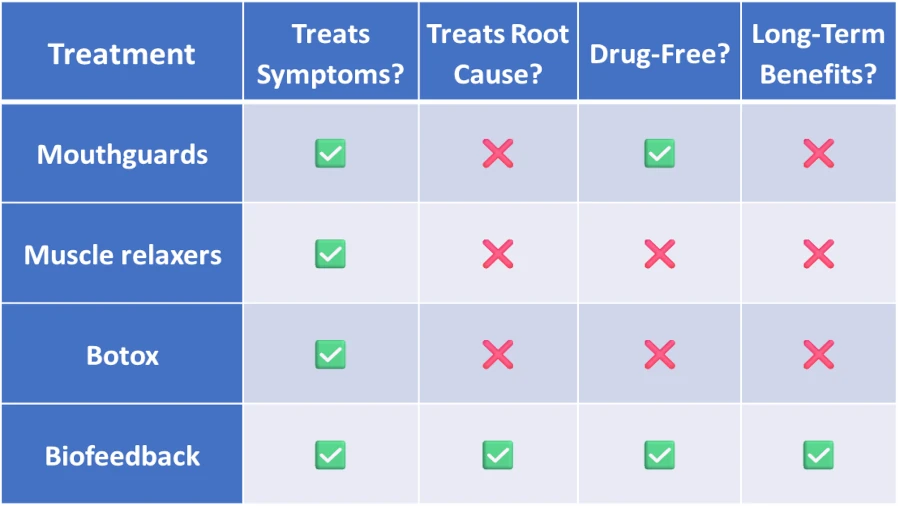
How Biofeedback Trains Your Brain to Stop Clenching
Here’s what happens during a biofeedback training session:
- Sensors detect tension in your jaw muscles (usually masseter and temporalis).
- You receive instant feedback (e.g., a beep, graph, or vibration).
- You consciously relax your jaw to stop the signal.
- Over time, your brain learns: “relaxed jaw = comfort, no tension = no alarm.”
This process:
- Interrupts unconscious clenching
- Reduces overactive nerve signaling
- Builds muscle memory for relaxation
Eventually, your body learns to stay relaxed—even during sleep.
Who Can Benefit from Biofeedback for Bruxism and Jaw Pain?
Everyone who clenches, grinds, or suffers from jaw tension can benefit, including:
- Sleep bruxism sufferers
- Daytime clenchers under stress
- Adults with chronic TMJ pain
- Post-surgical recovery patients
- Individuals with anxiety, ADHD, or sleep disorders
- Children and teens, with age-appropriate tools
Because biofeedback is gentle, safe, and non-drug-based, it’s suitable for almost every age group and condition severity.
How Fast Does Biofeedback Work for TMJ and Bruxism Relief?
With consistent use, most people report measurable improvements within 4 to 6 weeks:
- Week 1–2: Greater awareness of clenching triggers
- Week 3–4: Reduced muscle tightness and fewer episodes
- Week 5–6: Decreased jaw pain, morning headaches, and tooth sensitivity
- After 2–3 months: Muscle memory begins to hold, and device use can be reduced
Tip: Keep a journal or use your device’s tracking feature to monitor your progress.
Why Biofeedback Is the Missing Piece in TMJ and Bruxism Treatment
Most therapies (guards, pills, injections) ignore the nervous system’s role in the pain cycle. But biofeedback works by resetting the brain-muscle connection:
- Reduces activity in the trigeminal nerve (which controls jaw movement)
- Trains your brain to stay relaxed in high-stress moments
- Builds resilience through repetition
Bottom line: If your brain is causing the clenching, then retraining your brain will be the solution.
Summary
The Game-Changing Power of TMJ Biofeedback Therapy
A bruxism biofeedback device doesn’t just monitor your symptoms—it helps eliminate them. Unlike temporary fixes, biofeedback builds skills and body awareness that last.
- Helps you recognize unconscious tension
- Promotes natural muscle relaxation
- Treats the root cause—not just the symptoms
- Offers lasting TMJ and bruxism relief, without medication
You’re not stuck with clenching and jaw pain forever. With biofeedback, you can train your body to heal itself—naturally.
Step-by-Step Guide – How to Use a Bruxism Biofeedback Device for TMJ and Jaw Pain Relief
Now that you understand the power of biofeedback for bruxism and TMJ, it’s time to put it into practice. You don’t need to be tech-savvy or visit a clinic to get started. With the correct device and a simple daily routine, you can start retraining your jaw muscles today, right from the comfort of your own home.
Choose the Right Bruxism Biofeedback Device for Your Needs
Not all devices are created equal. The best option for you depends on the type of bruxism you have, when it occurs, and the severity of your symptoms.
Top Types of Biofeedback Devices for TMJ and Bruxism Relief:
1. EMG Biofeedback Devices (Electromyography)
- Measure electrical activity in the jaw muscles (masseter and temporalis)
- Provide real-time feedback through vibration, sound, or visuals
- Ideal for daytime clenching awareness and habit reversal
2. Nighttime Biofeedback Devices
- Detect grinding or jaw tension during sleep
- Use gentle alerts (like vibrations or beeps) to interrupt clenching patterns
- Best for sleep bruxism and people who wake with jaw pain or headaches
3. App-Based Biofeedback Devices
- Connect to your smartphone via Bluetooth
- Offer training programs, charts, and progress tracking
- Convenient for home use, even during travel
4. Clinical Biofeedback Systems
- Used under professional supervision
- Offer more detailed feedback and analysis
- Recommended for severe TMJ pain or complex neurological cases
Getting Started: Setting Up Your Biofeedback for TMJ Routine
You don’t need more than 10–15 minutes per session to begin seeing results. Here’s your action plan:
Attach the Device – Step 1
- Place EMG electrodes over the masseter muscles (sides of the jaw) or temporalis (above the temples)
- Ensure skin is clean and dry
- Follow your device’s instructions for placement and app syncing
Begin with Relaxation – Step 2
- Sit in a quiet place
- Keep lips together, teeth apart, and tongue resting lightly on the roof of your mouth
- Breathe deeply through your nose
Observe the Feedback – Step 3
- Your device will show or signal muscle tension in real time
- If clenching begins, the device will vibrate or beep
- When it does, pause, breathe, and gently release your jaw
Practice Daily – Step 4
- Start with 5–10 minutes per day, then increase gradually
- Use twice daily if symptoms are moderate to severe
- Most users notice a reduction in clenching within the first 2 weeks
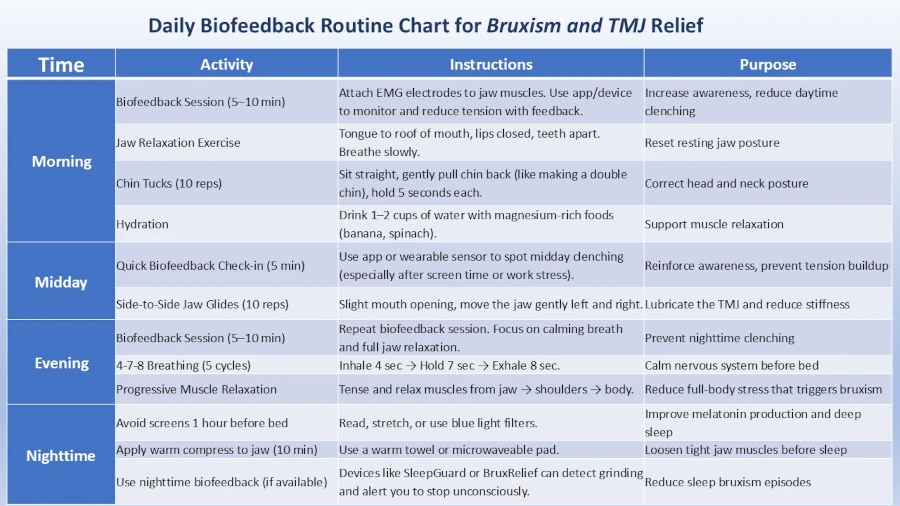
What to Expect Over Time – Your TMJ and Bruxism Progress Timeline
Here’s how your jaw retraining typically evolves with consistent practice:
Timeframe Expected Benefits
Week 1: Increased awareness of unconscious clenching
Weeks 2–3: Better control and less daytime tension
Weeks 4–6: Reduced jaw pain, fewer headaches
Week 6+ New relaxation patterns become automatic
Reminder: This is not a quick fix—it’s like physical therapy for your face. Consistency and patience = success.
Combine with Supportive Habits for Maximum Results
For faster and deeper relief, combine your bruxism biofeedback routine with the following:
Jaw Relaxation Techniques
- “Goldfish” exercises (gentle mouth opening and closing)
- Chin tucks (improve posture and relieve TMJ pressure)
- Side-to-side jaw movements
Stress Management Tools
- Diaphragmatic breathing (4-7-8 method)
- Progressive muscle relaxation (PMR)
- Daily mindfulness or meditation (10 mins)
Better Sleep Hygiene
- Avoid caffeine after 2 PM
- Use a contoured pillow to prevent jaw misalignment
- Try mouth taping if you mouth-breathe at night (after checking with a professional)
Popular Bruxism Biofeedback Devices to Consider
Here are trusted home-use options:
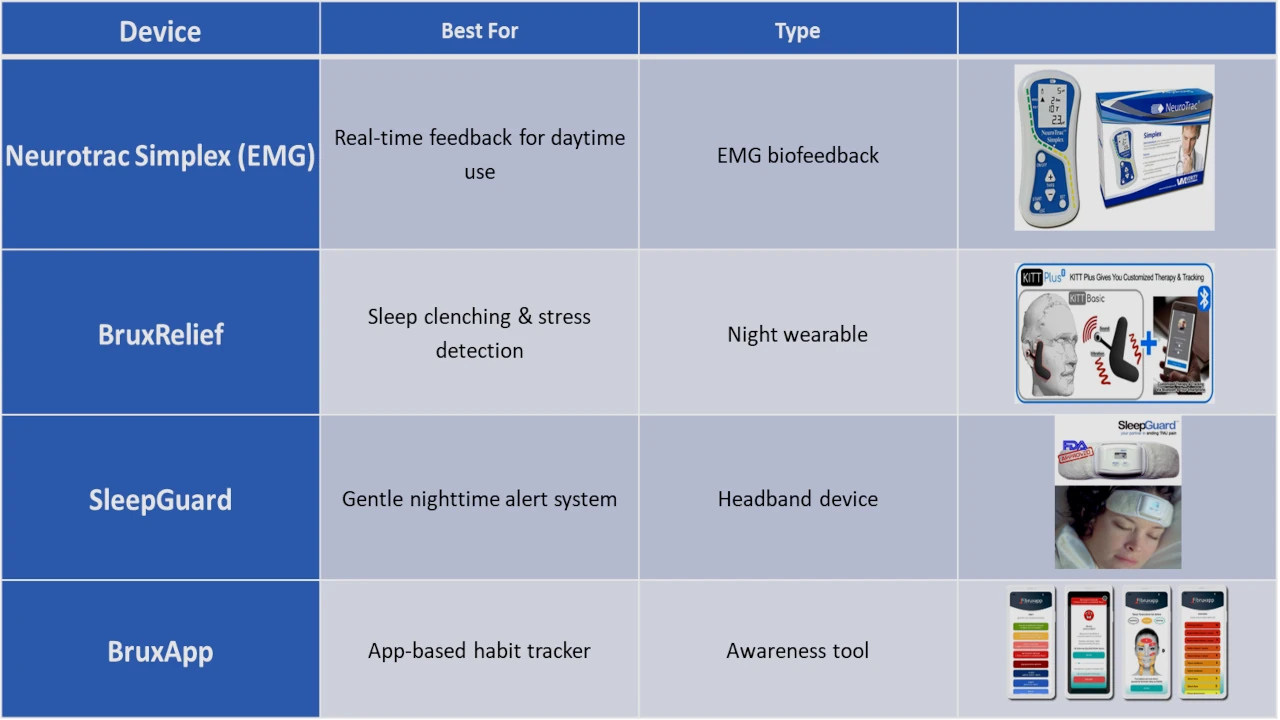
Tip: Start simple. Many users find Neurotrac Simplex (EMG) or BruxRelief to be ideal starting points.
Why This Works: Train Your Brain, Not Just Your Jaw
The goal of bruxism biofeedback isn’t just to “relax.” It’s to rewire your muscle memory, so your jaw stops clenching without conscious effort. Over time, the relaxation response becomes automatic—even during stressful moments or during deep sleep.
This is what makes biofeedback therapy so different—and more effective—than guards, drugs, or injections.
Take Charge of Your Healing with a TMJ Biofeedback Device.
You now have the tools to begin your biofeedback for jaw tension journey at home. With 10 minutes of practice a day, you’ll start reversing years of tension, clenching, and pain—naturally.
The Natural Boost – Exercises, Diet, and Stress Relief to Supercharge Your Bruxism and TMJ Recovery
While biofeedback for bruxism and TMJ works powerfully on its own, you’ll experience faster, longer-lasting relief when you pair it with supportive lifestyle changes. Think of this chapter as your booster plan: everything you can do to optimize your results, heal inflammation, and prevent future pain.
Jaw Exercises That Relieve Bruxism and Jaw Pain
Simple daily exercises help relax overactive jaw muscles, realign posture, and reduce strain on the temporomandibular joint.
Daily Jaw Relaxation Routine (5–7 minutes total) – Perform twice daily, in the morning and evening.
Tongue-to-Roof Hold – Trains neutral jaw posture
- Keep lips closed, teeth apart
- Lightly rest your tongue on the roof of your mouth
Chin Tucks – Reduces tech neck, which contributes to TMJ and bruxism
- Sit upright, tuck your chin inward to form a “double chin”
- Hold 5 seconds, repeat 10 times
Jaw Slides (Side-to-Side) – Improves TMJ mobility and coordination
- Open your mouth slightly
- Slowly slide the jaw left → center → right
Resisted Mouth Opening – Strengthens and stabilizes weak jaw muscles
- Place your thumb under your chin
- Try to open your mouth while gently resisting the movement
Pro tip: Always breathe slowly while exercising. Never force movement into pain.
Stress-Reduction Tools That Stop Unconscious Clenching
Stress is the #1 driver of bruxism and TMJ disorders. To stop grinding and clenching, your nervous system must shift from the “fight or flight” response to a state of “rest and relax.”
Diaphragmatic Breathing (The 4-7-8 Method) – Lowers cortisol and relaxes jaw muscles naturally
- Inhale through your nose for 4 seconds
- Hold for 7 seconds
- Exhale slowly for 8 seconds
- Repeat 4–6 cycles
Progressive Muscle Relaxation (PMR)
- Start at your toes and move upward
- Tense and release each muscle group (jaw, neck, and shoulders included)
- Perfect before bed or after stressful events
Mindfulness Meditation
- Sit quietly and focus on your breath or bodily sensations
- If your mind wanders, gently return to the breath
- Even 10 minutes a day improves stress resilience and jaw tension control.
Eat to Heal: The Anti-Inflammatory Diet for TMJ and Bruxism Relief
What you eat can either soothe your pain or fuel the fire. Chronic jaw inflammation worsens when your body is overloaded with inflammatory foods.
Foods to Include:
- Wild salmon, flaxseeds, walnuts (omega-3s for joint healing)
- Leafy greens, bananas, almonds (magnesium-rich for muscle relaxation)
- Berries, green tea (antioxidants reduce oxidative stress)
- Ginger, turmeric (natural COX-2 inhibitors for inflammation control)
Foods to Avoid:
- Crunchy or chewy items (gum, ice, raw carrots, jerky)
- Refined sugar and white flour (trigger systemic inflammation)
- Excess caffeine and alcohol (increase nighttime clenching and tension)
- Carbonated beverages (can worsen acid reflux, aggravating jaw pain).
Hydration Tip:
Drink at least 8–10 glasses of water per day. Dehydration tightens muscles, making your bruxism biofeedback training less effective.
Support Better Sleep to Prevent Nighttime Teeth Grinding
Sleep is the ultimate recovery tool. Poor sleep lowers pain tolerance, heightens anxiety, and leads to more nighttime grinding.
Sleep Hygiene Checklist for Bruxism Relief
- Turn off screens 1 hour before bed
- Avoid caffeine after 2 PM
- Use a supportive pillow to align the jaw and spine
- Try white noise or guided sleep meditations
- Consider mouth taping to promote nasal breathing (if safe for you).
Complementary Therapies to Try with TMJ Biofeedback
If your symptoms are severe or stubborn, combine biofeedback for jaw tension with one or more of these natural treatments:
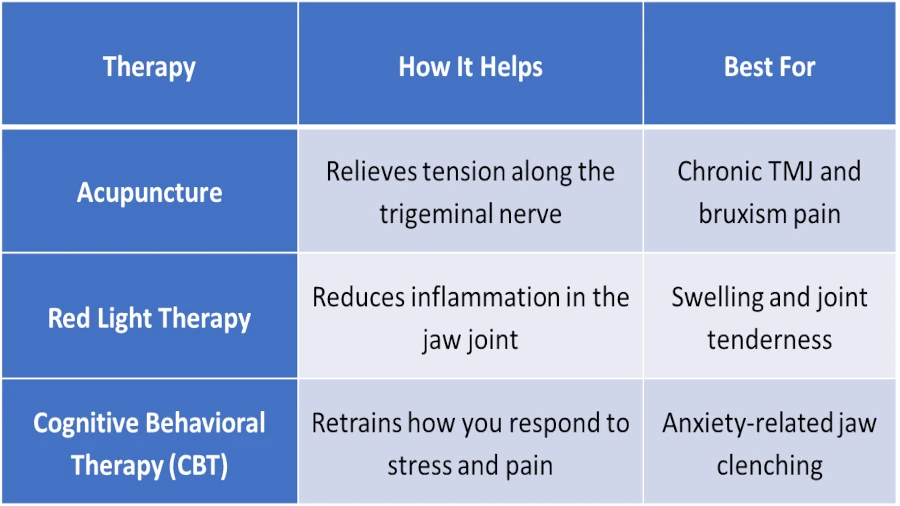
Combining physical, mental, and dietary support leads to faster healing and longer-lasting results.
Key Takeaway
Natural Strategies Multiply Your Bruxism Biofeedback Success.
Don’t treat your biofeedback device as a standalone fix. It’s a core tool, but your daily habits are the engine of healing.
To accelerate your recovery:
- Stretch your jaw and neck daily
- Eat to reduce inflammation
- Calm your nervous system
- Sleep like your health depends on it (because it does)
Bruxism and TMJ pain relief is absolutely possible—and completely natural.
Bruxism and TMJ FAQs About Biofeedback, Relief, and Recovery
Biofeedback isn’t a “cure” in the traditional sense—it’s a training method. It helps you recognize and reduce unconscious clenching and retrains the nervous system.
Many users experience:
- 50–70% reduction in bruxism symptoms,
- Less pain, better sleep, and improved jaw function,
- Long-term relief, especially when combined with lifestyle changes.
It varies by individual, but typical results include:
- Week 1–2: Better awareness of tension,
- Week 3–4: Reduced clenching and muscle tightness,
- Week 5–6: Noticeable relief in jaw pain, stiffness, and sleep quality.
Consistency is key. Think of it as physical therapy for your jaw.
Yes. Biofeedback is a non-invasive, drug-free, and safe treatment option, even for long-term use. It’s suitable for:
- Children (8+ years with supervision)
- Adults of all ages
- People with chronic TMJ and bruxism pain
Exceptions:
- Individuals with pacemakers should avoid EMG units with electrical stimulation.
- People with photosensitive epilepsy should avoid visual feedback with flashing patterns.
Yes, but not all devices support this. Look for sleep-specific biofeedback devices like:
- SleepGuard,
- BruxRelief wearable,
- Smart headbands with vibration alerts.
These tools gently interrupt clenching episodes during sleep without fully waking you.
Not necessarily. A biofeedback device trains you not to clench, while a night guard only protects your teeth. Many people eventually stop using guards altogether after successful training.
That said, some combine both temporarily—using the night guard while retraining the brain with biofeedback.
Conclusion: Take Back Control – End Bruxism and TMJ Naturally and Permanently
You’ve reached the final chapter of your journey to understanding and healing bruxism and TMJ disorders—and that’s a huge step. You’ve learned how:
- Jaw pain, teeth grinding, and TMJ dysfunction are often driven by unconscious patterns, stress, and lifestyle habits
- Conventional treatments often offer temporary relief without retraining your body
- A bruxism biofeedback device empowers you to stop clenching, reduce pain, and prevent damage naturally
- Supporting changes—exercises, diet, posture, sleep, and relaxation—multiply your success
Here’s What You Can Do Today:
- Choose a trusted biofeedback device for jaw pain relief.
- Set aside just 10–15 minutes a day for training.
- Pair it with simple habits that promote healing and protection of your jaw.
- Stay consistent, track progress, and adjust as needed.
References
Bartolucci ML, Incerti Parenti S, Bortolotti F, Della Godenza V, Vandi S, Pizza F, Plazzi G, Alessandri-Bonetti G. Sleep Bruxism and Orofacial Pain in Patients with Sleep Disorders: A Controlled Cohort Study. J Clin Med. 2023 Apr 20;12(8):2997. doi: 10.3390/jcm12082997. PMID: 37109339; PMCID: PMC10142632.
Ilovar S, Zolger D, Castrillon E, Car J, Huckvale K. Biofeedback for treatment of awake and sleep bruxism in adults: systematic review protocol. Syst Rev. 2014 May 2;3:42. doi: 10.1186/2046-4053-3-42. PMID: 24886985; PMCID: PMC4028105.
Bruxism (Teeth Grinding). (https://my.clevelandclinic.org/health/diseases/10955-teeth-grinding-bruxism). 12/18/2023.
National Sleep Foundation (U.S.). The Link Between Sleep Apnea and Teeth Grinding (https://www.sleepfoundation.org/sleep-apnea/link-between-sleep-apnea-and-teeth-grinding).
TMD / TMJ Disorder & Bruxism. Neurology Solutions. (https://www.neurologysolutions.com/movement-disorders/tmd-tmj-disorder-bruxism/).




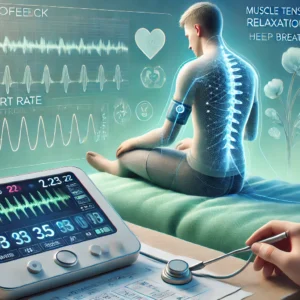
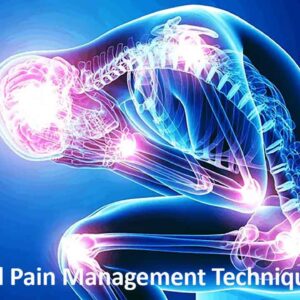
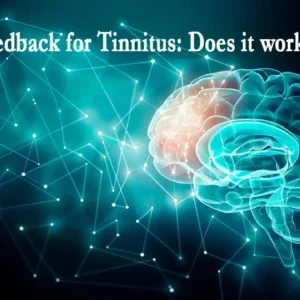
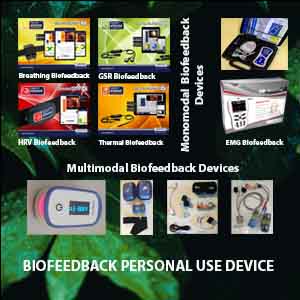
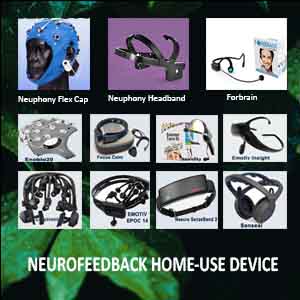
Add a Comment